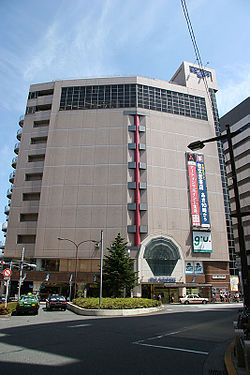Keiō-Hachiōji Station
| Keiō-Hachiōji ( 京 王八 王子 ) | |
|---|---|
|
Entrance to the train station in the
K-8 shopping center (June 2007) |
|
| Data | |
| Location in the network | Terminus |
| Design | Tunnel station |
| Platform tracks | 2 |
| abbreviation | KO34 |
| opening | March 24, 1925 |
| location | |
| City / municipality | Hachiōji |
| prefecture | Tokyo |
| Country | Japan |
| Coordinates | 35 ° 39 '29 " N , 139 ° 20' 35" E |
| Height ( SO ) | 105 m TP |
| Railway lines | |
| List of train stations in Japan | |
The station Keiō-Hachiōji ( Japanese 京 王八 王子 駅 , Keiō-Hachiōji-eki ) is a train station on the Japanese island of Honshū . It is operated by the Keiō Dentetsu railway company and is located in Tokyo Prefecture in the area of the city of Hachiōji .
description
Keio Hachioji is an underground end station and the western terminus of Keio line , which Fuchū , Chōfu and Meidaimae according Shinjuku in the center of Tokyo leads. Six trains per hour are offered, with the train types changing depending on the time of day and skipping a different number of intermediate stations. Local trains only serve the station early in the morning and late in the evening, otherwise you have to change trains at the next station in Kitano .
The tunnel station is located in the central district of Myōjinchō. It is oriented from south-east to north-west and has two blunt- ended tracks on a central platform . The track level is in the second basement, a distribution level occupies the first basement. Above it rises the eleven-storey K-8 (Kei-hachi) shopping center with more than 60 shops, which, like the railway company, belongs to the Keio Group . A bus station with ten bus platforms is integrated into the building . It is served by more than 50 bus routes from the companies Keiō Dentetsu Bus , Keiō Bus Minami and Nishi Tōkyō Bus . About 400 meters to the southwest is the Hachiōji station on the Chūō main line .
In the 2018 fiscal year, an average of 59,486 passengers used the station every day.
Tracks
| 1/2 | ▉ Keiō line | Fuchū • Chōfu • Meidaimae • Shinjuku |
photos
history
The Gyokunan Tetsudo , a 1922 subsidiary founded Keio Denki Kido (now Keio Dentetsu ), opened the station on March 24, 1925. At that time he was called Higashi-Hachiōji ( 東八王子 ) and was above ground on Kōshū Kaidō (today's National Road 20 ) , about 200 meters northwest of the current location. The railway line leading to Fuchū was built in Kapspur (1067 mm) because the state had promised funding for it. When this did not materialize, the Gyokunan Tetsudō went on December 1, 1926 in its parent company. This then carried out a re-gauging , which was completed on June 1, 1927 and enabled continuous connections to Shinjuku from May 1928 . From 1929 to 1939 there was a connection to the tram line of the Musashi Chūō Denki Tetsudō .
An air raid by the United States Army Air Forces on August 2, 1945 caused severe damage. The temporarily rebuilt station was moved to its current location on December 11, 1963 and renamed Keiō-Hachiōji. The previously single-track section to the neighboring Kitano station was given a second track on June 3, 1970, with the result that the entire Keiō line was now expanded to double-track. The capacity of the above-ground terminus remained limited as it was too short for express trains with ten cars. For this reason, it was moved underground at the same location. After several years of construction, the tunnel station was put into operation on April 2, 1989. The K-8 shopping center, which opened its doors on September 15, 1994, was built on the disused site.
Adjacent train stations
|
←
|
Lines |
→
|
||
|---|---|---|---|---|
| Kitano |
Keiō Dentetsu |
The End | ||
| Beginning |
(1929–1939) |
Keiō-ekimae | ||
Web links
- Keiō Dentetsu station information (Japanese)
Individual evidence
- ↑ Timetable from Keiō-Hachiōji. Keiō Dentetsu , 2019, accessed February 16, 2020 (Japanese).
- ↑ 京 王 グ ル ー プ 1 日 の 駅 別 乗 降 人員. Keiō Dentetsu, 2018, accessed February 16, 2020 (Japanese).
- ↑ a b Keiō Dentetsu (Ed.): 京 王 ハ ン ド ブ ッ ク 2016 . (Keiō Handbook 2016). Tama 2016.




